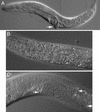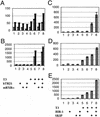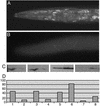BIR-1, a Caenorhabditis elegans homologue of Survivin, regulates transcription and development
- PMID: 12682297
- PMCID: PMC154329
- DOI: 10.1073/pnas.0730770100
BIR-1, a Caenorhabditis elegans homologue of Survivin, regulates transcription and development
Abstract
bir-1, a Caenorhabditis elegans inhibitor-of-apoptosis gene homologous to Survivin is organized in an operon with the transcription cofactor C. elegans SKIP (skp-1). Because genes arranged in operons are frequently linked functionally, we have asked whether BIR-1 also functions in transcription. bir-1 inhibition resulted in multiple developmental defects that overlapped with C. elegans SKIP loss-of-function phenotypes: retention of eggs, dumpy, movement defects, and lethality. bir-1 RNA-mediated interference decreased expression of several gfp transgenes and the endogenous genes dpy-7 and hlh-1. Immunoblot analysis revealed decreased phosphoacetylated histones in bir-1 RNA-mediated interference-treated worms. In a heterologous transfection system, BIR-1 augments thyroid hormone-regulated transcription and has an additive effect with SKIP. These results show that BIR-1 functions in the regulation of transcription and development.
Figures





Similar articles
-
BIR-1, the homologue of human Survivin, regulates expression of developmentally active collagen genes in C. elegans.Folia Biol (Praha). 2006;52(4):101-8. Folia Biol (Praha). 2006. PMID: 17116281
-
Caenorhabditis elegans inhibitor of apoptosis protein (IAP) homologue BIR-1 plays a conserved role in cytokinesis.Curr Biol. 1999 Mar 25;9(6):292-301. doi: 10.1016/s0960-9822(99)80137-7. Curr Biol. 1999. PMID: 10209096
-
SKIP and BIR-1/Survivin have potential to integrate proteome status with gene expression.J Proteomics. 2014 Oct 14;110:93-106. doi: 10.1016/j.jprot.2014.07.023. Epub 2014 Aug 1. J Proteomics. 2014. PMID: 25088050
-
Studying gene function in Caenorhabditis elegans using RNA-mediated interference.Brief Funct Genomic Proteomic. 2008 May;7(3):184-94. doi: 10.1093/bfgp/eln019. Epub 2008 Apr 28. Brief Funct Genomic Proteomic. 2008. PMID: 18443013 Review.
-
Proteomics in Caenorhabditis elegans.Brief Funct Genomic Proteomic. 2008 May;7(3):205-10. doi: 10.1093/bfgp/eln014. Epub 2008 Mar 27. Brief Funct Genomic Proteomic. 2008. PMID: 18372286 Review.
Cited by
-
Survivin selectively modulates genes deregulated in human leukemia stem cells.J Oncol. 2011;2011:946936. doi: 10.1155/2011/946936. Epub 2010 Dec 23. J Oncol. 2011. PMID: 21253548 Free PMC article.
-
Transcriptional and post-transcriptional controls of survivin in cancer cells: novel approaches for cancer treatment.J Exp Clin Cancer Res. 2006 Sep;25(3):391-402. J Exp Clin Cancer Res. 2006. PMID: 17167980 Free PMC article. Review.
-
Survivin modulates genes with divergent molecular functions and regulates proliferation of hematopoietic stem cells through Evi-1.Leukemia. 2015 Feb;29(2):433-40. doi: 10.1038/leu.2014.183. Epub 2014 Jun 6. Leukemia. 2015. PMID: 24903482 Free PMC article.
-
Survivin contributes to DNA repair by homologous recombination in breast cancer cells.Breast Cancer Res Treat. 2016 Jan;155(1):53-63. doi: 10.1007/s10549-015-3657-z. Epub 2015 Dec 18. Breast Cancer Res Treat. 2016. PMID: 26679694 Free PMC article.
-
Survivin promotes a glycolytic switch in CD4+ T cells by suppressing the transcription of PFKFB3 in rheumatoid arthritis.iScience. 2022 Nov 7;25(12):105526. doi: 10.1016/j.isci.2022.105526. eCollection 2022 Dec 22. iScience. 2022. PMID: 36425763 Free PMC article.
References
Publication types
MeSH terms
Substances
LinkOut - more resources
Full Text Sources
Molecular Biology Databases

